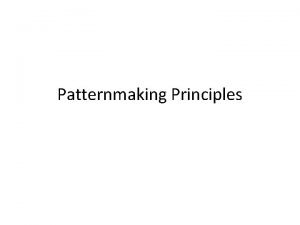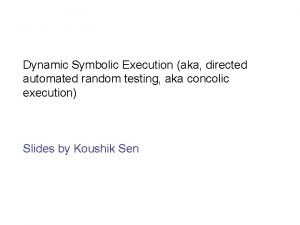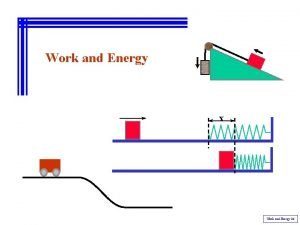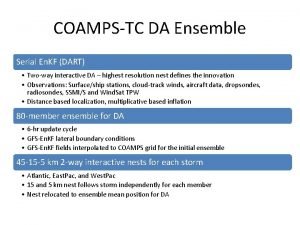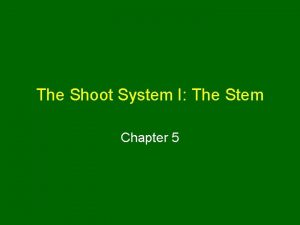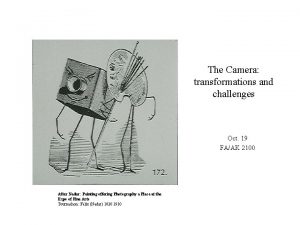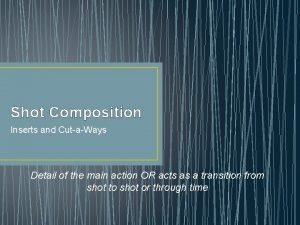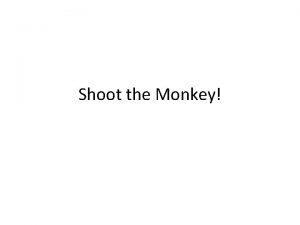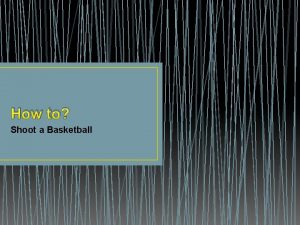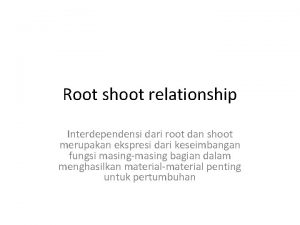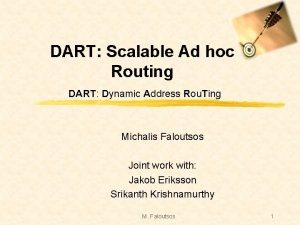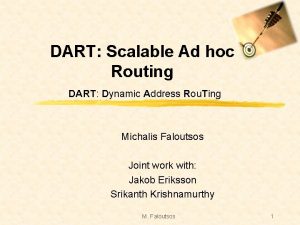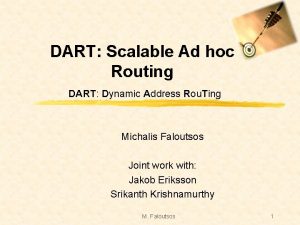Journal 25 If you shoot a dart at
































- Slides: 32

Journal #25 �If you shoot a dart at a low angle (0 ), then continue to shoot at a greater and greater angle (90 ), predict how will that effect… the distance the dart travels? the time the dart spends in the air?

Chapter 6 MOTION IN TWO DIMENSIONS

6. 1 - Projectile Motion �A projectile is an object that is shot through the air. �Three types of projectiles: �Projectiles shot vertically (90 o) �Projectiles shot horizontally (00) �Projectiles shot at an angle (between 0 and 90 o)

Projectiles �The path that a projectile takes while in flight is called the trajectory. The shape of this path is called a parabolic curve (or parabola). �The horizontal distance that the projectile travels is called its range. �The highest point in the trajectory is called the maximum height.

Hangtime �The time a projectile spends in the air is called its hangtime. �If shot horizontally, the time is only the time down. �If shot at any angle greater than 0 degrees, the projectile will travel up for a while, then down. The time up is equal to the time down. �The closer the launch angle is to 90 o, the more time the projectile will spend in the air.

Diagram of Horizontal Projectile vx vx= horizontal velocity dy= vertical height t = time to fall dx= range dy t dx

Diagram of an Angled Projectile Time up equals time down dy-max dx

Horizontal Projectile Formulas �The horizontal velocity of a projectile stays constant while in flight. Same formula from Chapter 2:

Horizontal Projectile formulas �To find the time a horizontal projectile stays in the air, you only need to know the height from which it was dropped. �The only acceleration for a projectile is that of gravity.

Horizontal Projectile Formulas �To find the vertical velocity of a projectile that was initially shot horizontally, you will need to know the time that it was in the air. �When a projectile is shot horizontally, the initial vertical velocity is zero. �The acceleration is equal to 9. 80 m/s 2.

Example �A ball is thrown from the top of a 125 m tall structure with an initial horizontal velocity of 15 m/s. How long will it take for it to hit the ground? How far will it land from the base of the structure? What was the vertical component of the velocity immediately before the ball hit the ground?

Homework � p. 150, #1 -3

Journal # 26 �An arrow is shot horizontally from 2. 0 m above the ground and lands 75 m away from the shooter. How long was it in the air? What was the initial speed of the arrow?

Answers to HW

Answers to HW

Journal #27 �A rock is thrown horizontally with a speed of 12. 5 m/s off a 75. 0 m cliff. How long does it take the rock to hit the ground? How far from the base of the cliff does the rock land? What are the horizontal and vertical components of the ball’s velocity just before it strikes the ground?

Journal #28 �Using the what you learned from the projectile lab, What launch angle for a projectile will produce the largest displacement? What launch angle for a projectile will produce the largest hangtime? Draw a sketch of an angle vs. distance graph like the one made in lab.

6. 2 - Circular Motion �There are many objects that do not travel in straight lines or move along a trajectory. �Some objects travel in a circular motion: Blades of a fan Cars going around a curve Satellites orbiting the earth

Uniform Circular Motion �The movement of an object or particle trajectory at a constant speed around a circle with a fixed radius (r). �As an object moves around the circle, the length of the radius does not change. �The acceleration of the object is toward the center of the circle causing the velocity to stay at a tangent. A tangent line is a line that passes through a single point of a circle and is perpendicular to the radius of that circle.

Diagram of Circular Motion

Centripetal Acceleration �Centripetal acceleration always points to the center of the circle. Its magnitude is equal to the square of the velocity, divided by the radius of circular motion.

How can you measure the speed of an object moving in a circle? � Speed is still calculated as distance traveled divided by the time it takes to travel that distance. � In the case of circular motion, the distance is the circumference of a circle or (2πr). � The time it takes to go around a circle one time is called the period (T).

The “New” Net Force? We know that an object must have a force acting on it for it to accelerate… so what is this mysterious force that is pulling or pushing towards the center of the circle? �A net force that in a direction towards the center of a circle is called the centripetal force.

Centripetal Force �The centripetal force is really a costume artist… it can be whichever force is causing the acceleration to the center of the circular motion. �Examples: A car going around a curve - Friction Force A satellite in orbit - Force of Gravity A ball on a string - Tension Force �The first step for any circular motion problem is to identify the force that is acting as the centripetal force.

Using Newton’s Second Law Again �Newton’s 2 nd Law stated that net force on an object is equal to the mass times the acceleration. �This holds true, but we substitute in centripetal acceleration:

Does Centrifugal Force Exist? ? ? �If you have ever been in a car that suddenly turned to the left, your body may have been thrown to the right… does that mean that there is some outward force? �No… the car around you has moved and you have tried to maintain your original path (according to Newton’s 1 st Law).

Does Centrifugal Force Exist? ? ?

Example 1 �An athlete whirls a 7. 00 kg hammer 1. 8 m from the axis of rotation in a horizontal circle. The hammer makes one revolution in 1. 0 s. What is the centripetal acceleration of the hammer? What is the tension in the chain?

Homework Update: ALL DUE MONDAY �Pg 150 # 1 -3 �Pg 156 # 12 -15 �Pg 165 # 51 -53, 55, 58, 59 �Pg 166 # 61, 64, 66, 67 Today’s Lab Calculations and Conclusions are due Friday!!!!

Today’s Tasks �Final Project Copies, Building Instructions, Misc. �Circular Motion Lab Calculation Instructions �Projectile Lab Groups and Pre-Lab Discussion -Decide on roles -Pre lab assignments ready for tomorrow

Journal # 29 �If a 0. 40 kg stone is whirled horizontally on the end of a 0. 60 m string at a speed of 2. 2 m/s, what is the tension in the string?

HW: P. 156, #12 -15
 Expert system architecture in ai
Expert system architecture in ai Esquema dart displasia broncopulmonar
Esquema dart displasia broncopulmonar Adaptation of poison dart frog
Adaptation of poison dart frog Dart equivalent
Dart equivalent Vx=vcosθ
Vx=vcosθ Esquema dart para extubação
Esquema dart para extubação Mqtt ventajas y desventajas
Mqtt ventajas y desventajas Dart fedora
Dart fedora Directed automated random testing
Directed automated random testing Dart problem solving
Dart problem solving Work energy theorem
Work energy theorem Dart formuleren
Dart formuleren Http://www.dart-europe.eu/basic-search.php
Http://www.dart-europe.eu/basic-search.php Dart serial port
Dart serial port Sql dart
Sql dart Dart aiu
Dart aiu Mimic poison dart frog
Mimic poison dart frog Mimic poison dart frog
Mimic poison dart frog Dart nurse
Dart nurse Mimic poison dart frog
Mimic poison dart frog Virtual dart
Virtual dart Http://www.dart-europe.eu/
Http://www.dart-europe.eu/ Flutter/dart
Flutter/dart Curare plant
Curare plant Pont du gare
Pont du gare Dendrobates fantasticus
Dendrobates fantasticus Dart referral
Dart referral Function of the shoot system
Function of the shoot system Jeff wall photography
Jeff wall photography Fly shoot adalah
Fly shoot adalah Cut away film shot
Cut away film shot External parts of a leaf
External parts of a leaf Chris burden shoot
Chris burden shoot



